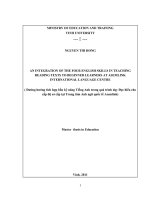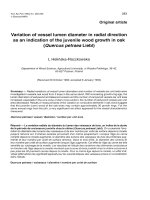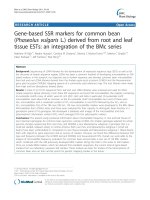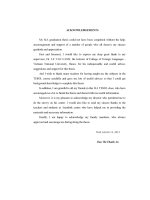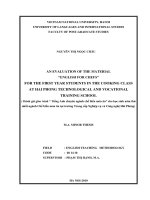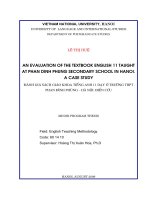An integration of the four english skills in teaching reading texts to beginner learners at asemlink international language centre
Bạn đang xem bản rút gọn của tài liệu. Xem và tải ngay bản đầy đủ của tài liệu tại đây (435.5 KB, 90 trang )
MINISTRY OF EDUCATION AND TRAINING
VINH UNIVERSITY
--- --NGUYEN THI HONG
AN INTEGRATION OF THE FOUR ENGLISH SKILLS IN TEACHING
READING TEXTS TO BEGINNER LEARNERS AT ASEMLINK
INTERNATIONAL LANGUAGE CENTRE
( Đường hướng tích hợp bốn kỹ năng Tiếng Anh trong quá trình dạy Đọc hiểu cho
cấp độ sơ cấp tại Trung tâm Anh ngữ quốc tế Asemlink)
Master thesis in Education
Vinh, 2011
1
MINISTRY OF EDUCATION AND TRAINING
VINH UNIVERSITY
--- --NGUYEN THI HONG
AN INTEGRATION OF THE FOUR ENGLISH SKILLS IN TEACHING
READING TEXTS TO BEGINNER LEARNERS AT ASEMLINK
INTERNATIONAL LANGUAGE CENTRE
( Đường hướng tích hợp bốn kỹ năng Tiếng Anh trong quá trình dạy Đọc hiểu cho
cấp độ sơ cấp tại Trung tâm Anh ngữ quốc tế Asemlink)
Field: Theory and Methodology of English Language Teaching
Code: 60.14.10
Master thesis in Education
Supervisor: Dr. LE VAN CANH.
Vinh, 2011
2
STATEMENT OF AUTHORSHIP
I certify myself of the Study Project Report submitted entitled “ An integration of the
four English skills in teaching reading text to beginner learners at Asemlink centre” in
partial fulfillment of the requirements for the degree of Master of Arts.
Vinh 2011
Nguyen Thi Hong
3
ACKNOWLEDGEMENT
I would like to thank the Department of Postgraduate Studies at Vinh University for
giving me opportunity to accomplish this study. I would also like to thank my supervisor
Dr. Le Van Canh for his useful advice and encouragement while working on the thesis.
Also I wish to express my gratitude to all the lectures at the Department of Postgraduate
Studies, who have provided me with valuable knowledge in the field of English
Teaching Methodology during the MA course.
4
ABSTRACT
This thesis analyzes the exploitation of the integrated approach in teaching reading text
to beginner learners at Asemlink school. The main theoretical basis of this study is
Brown (2001)’s theory of integration. It is an action research, in which the benefits of the
integrated approach to language teaching are proposed beforehand concerning the use of
the integrated approach to teaching reading text to beginner learners. The research begins
with the construction of the integrated approach to language teaching. This will be then
the theoretical framework for the later analysis of the students’ questionaires after
studying with this teaching method. The job of analysis aims at finding the benefits of
the integrated approach that students perceived and students’ attitude toward the
integrated approach in learning reading text. The result is, later on, used for proving the
importance of integrating the English skills in teaching reading text.
LIST OF TABLES AND FIGURES
5
Table 2.1 . Types of integration ................................................................................... 19
Table 4.1. Problems of learning reading comprehension............................................. 55
Table 4.2. Students’ attitude toward the integration of other skills in teaching reading
comprehension...............................................................................................................57
Table 4.3. Benefits of the integrated approach..............................................................60
Figure 4.1. Students’ attitudes toward the integrated approach ..................................63
Figure 4.2. Reasons for their interest in the integrated approach ...............................64
TABLE OF CONTENT
6
STATEMENT OF AUTHORSHIP....................................................................................3
ACKNOWLEDGEMENT..................................................................................................4
ABSTRACT.......................................................................................................................5
CHAPTER 1 - INTRODUCTION......................................................................................9
1.4.1. An Action Research ...........................................................................................12
1.4.2. Methods..............................................................................................................13
1.6. Organization of the study .....................................................................................14
CHAPTER 2 – LITERATURE REVIEW........................................................................16
2.1.1.The role of reading in second/foreign language acquisition...............................16
2.1.2. Students’ difficulties in reading comprehension................................................18
2.1. 3. Approaches to teaching reading comprehension...............................................19
2.1.3.1.Bottom-up model..............................................................................................20
2.1.3.2. Top-down model .............................................................................................20
2.1.3.3. Interactive model.............................................................................................21
2.2. The power of extensive reading.............................................................................21
2.3.1. Definition ...........................................................................................................23
2.3.2.Types of integration.............................................................................................24
2.4.Integration of skills.................................................................................................25
2.4.1. Integration of three areas....................................................................................25
2.4.1.1. Grammatical integration..................................................................................25
2.4.1.2 Functional integration.......................................................................................26
2.4.1.3. Thematic/ Topical integration..........................................................................26
2.5. Reading integrated with other skills......................................................................26
2.5.1. Reasons for the integration of Reading with other skills....................................26
2.5.2. The integration of reading with other skills........................................................28
2.5.2.1. Reading integrated with Listening...................................................................28
2.5.2.2. Reading integrated with writing......................................................................30
2.5.2.3. Reading integrated with Speaking...................................................................31
2.6.Benefits of the integrated approach to language teaching......................................32
2.7. Challenges and Limitations of the integrated approach to language teaching.......36
2.8. Student’s perceptions of teachers’ teaching styles................................................37
2.8.1. Definition of perception......................................................................................37
2.8.2. Teachers’ teaching styles....................................................................................38
2.8.3. Learners’ learning styles.....................................................................................40
2.8.4. Studies on students’ perception of teachers’ teaching styles. ............................41
2.8.4.2. Study on Students’ perception of teachers’ teaching styles in Higher
Education......................................................................................................................42
2.8.4.3. Students’ perception of learner – centered teaching.......................................43
2.9. Conclusion.............................................................................................................45
CHAPTER 3 - METHODOLOGY...................................................................................46
3.2.1. Indentify the problems........................................................................................47
7
3.2.2. Planning for the Intervention..............................................................................49
3.2.3. Implementation...................................................................................................50
3.2.4.Evaluation............................................................................................................51
3.3.1. Use students’ questionaire..................................................................................51
3.3.2. Teacher’s journals / Diaries................................................................................52
CHAPTER 4 - FINDINGS AND DISCUSSION.............................................................56
4.1. The results ............................................................................................................56
4.1.1. Students’ problems in learning only reading skill in reading comprehension....56
Table 4.1. Problems of learning reading comprehension.................................................56
4.1.2. Students’s attitudes toward the way to learn reading comprehension with other
skills..............................................................................................................................59
Table 4.2. Students’ attitude toward the integration of other skills in teaching reading
comprehension..................................................................................................................59
4.1.3. Benefits of the integrated approach....................................................................60
4.1.4. Students’ attitudes toward the integrated approach............................................63
Figure 4.1. Students’ attitudes toward the integrated approach........................................64
Figure 4.2. Reasons for their interest in the integrated approach.....................................65
4.1.5. Reasons for choosing the integrated approach to teaching reading text ............66
4.2. Findings and Discussion........................................................................................67
4.2.1. Students’ perceived benefits of the integrated approach to their English learning
......................................................................................................................................68
4.2.2. Students’ perceived difficulties of the integrated approach to their English
learning.........................................................................................................................70
4.2.3. Reflection...........................................................................................................71
4.3. Conclusion.............................................................................................................72
CHAPTER 5 - CONCLUSION....................................................................................73
REFERENCES.................................................................................................................77
APPENDIX 1...................................................................................................................80
APPENDIX 2...................................................................................................................83
APPENDIX 3...................................................................................................................86
8
CHAPTER 1 - INTRODUCTION
When we are teaching a second language, we are trying to develop in the learners
not just grammatical competence in the Chomskyan sense , but also communicative
competence.
Integrating the four English skills : Listening, Reading, Writing and Speaking is
one of the effective ways of teaching English to develop learners’ communicative skill.
According to Davies & Pearse:
“ Real success in English teaching and learning is when the learners can
actually communicate in English inside and outside the classroom”
(Davies & Pearse, 2000: 99).
Teachers have been studying the ways of enabling learners to use English freely,
effectively and as far as possible accurately. It is not only the major goal of all English
language teaching , but also the students’ main concern when they make their efforts to
study English. Therefore , it is necessary to combine four skills at once when we teach
English for students to let them use what they learn in realistic communication.
For various reasons, traditional English language teaching ( ELT) tends to train
the four skills – listening, speaking, reading and writing seperately. And then materials
and activites are designed to focus on one specific skill while others are ignored. It
cannot be denied that a separate focus on individual skills can play a useful role in
accelerating students’ language learning if it is taught well. However, students cannot
communicate well when they are in real life because there is no seperation of four skills
outside. All of these skills are combined together. Hence, integrated approach in
language teaching is used to develop students’ communicative comptetence. Integrating
the skills can bring plenty of benefits to English teaching. It is a worthwhile experience
in a communicative classroom despite its higher demanding for teachers.
9
In this thesis, I would like to show an integrated approach to the teaching and
practice of the language skills through reading lessons. With this approach, the language
classroom will become more purposeful and meaningful for the learners at all levels if
we apply this method.
Integrating the four English skills in teaching can make classroom contexts and
situations come closer to the real life ones. Moreover, it can help learners develop the
four skills at the same time. Then they can communicate well outside.
To sum up, it is observed that integrated approach to language teaching can bring
an effective result to learners’communicative competence. In this thesis, I would like to
mention the integrated approach to language teaching and then through reading lesson, I
would like to integrate the four skills through some activities.
1.1. Rationale
Teaching English gives students not only grammar knowledge but also their
fluency of four English skills: reading, writing, listening and speaking at different levels.
From my teaching experiences, It is apparent that Vietnamese learners are very good at
grammar , however they are not fluent at the four English skills. Therefore, it is very
difficult for them to communicate with foreigners when they work outside. In fact , many
countries in the world have applied the communicative method to teach learners to study
English effectively for a long time. However, We have just applied this method in
teaching English recently. Moreover, Our students have also just taken a serious view
with the importance of English.
Realizing the significance of integrating four skills in teaching English for
beginners to get good communicative skills, this study is carried out to investigate the
ways to integrate four skills in teaching Reading and to suggest some kinds of activities
that teachers can create through the reading text to combine four skills.
1.2. Aims and Objectives of the study
10
This study deals with the ways to integrate four English skills : speaking, reading,
writing and listening in teaching Reading for beginners at Asemlink International
language centre in Vinh city and to suggest some activities that teacher can create to
motivate students to improve all of four skills through Reading lesson.
In other words, this study aims specifically at:
(1) Identifying the problem of beginners when they study reading lessons which
base on traditional English language teaching
(2) Investigating the integrated approach to language teaching to beginners : its
benefits and limitations.
(3) Designing some kinds of activities to integrate the four English skills in
teaching reading lesson which aims at improving students’ communicative competence
when they communicate in real life.
1.3. Scope of the study
In this study, I would like to focus on beginners who are attending General
English Program ( GEP ) in my English centre ( AsemLink International Language
Centre).
As it is a methodologically based analysis, this study would primarily deal with
methodological aspects of English. In this study, I would like to pay more attention to
reading lessons. Then from reading lessons, I would like to create some activities to
improve four English skills : speaking, writing, reading and listening. From my teaching
experience, I have found that Vietnamese learners can get good knowledge about
English. However, it seems to be quite difficult for learners to combine the four skills in
their daily communication. Therefore, I would like to focus on this study to find some
ways to improve students’ English skills.
1.4. Research Methodology
11
1.4.1. An Action Research
This study represents itself as an action research. Action research is “learning by
doing” - a group of people identify a problem, do something to resolve it, see how
successful their efforts were, and if not satisfied, try again. While this is the essence of
the approach, there are other key attributes of action research that differentiate it from
common problem-solving activities that we all engage in every day.
What makes this type of research different from general professional practices,
consulting, or daily problem-solving is the emphasis on scientific study, which is to say
the researcher studies the problem systematically and ensures the intervention is
informed by theoretical considerations. The researchers spend much time on refining the
methodological tools to suit the exigencies of the situation, and on collecting, analyzing,
and presenting data on an ongoing, cyclical basis.
What makes action research suitable for this study is because of the following
reasons. Firstly, to investigate this study I myself must practice teaching in real classes
and get the results from my own teaching when I apply the integrated approach in
teaching Reading. Another reason is that this study is used in real situations – at my
English centre, rather than in contrived, experimental studies since its primary goal is on
solving real problems. As it is introduced by Thomas Gilmore, Jim Krantz and Rafael
Ramirez :
"Action research...aims to contribute both to the practical concerns of
people in an immediate problematic situation and to further the goals of
social science simultaneously”. ( 1986:161)
Therefore, it is suitable to use action research in this study.
12
1.4.2. Methods
Because it is an action research , I would like to base on the following methods to
investigate my study. First of all, this study combines both qualitative and quantitative
methods. The reason for doing is that at the first stage of the research, the qualitative
analysis may allow us to study each specific case carefully, but when it comes to the
general picture of all cases together, it may fail. Therefore, we need a kind of
quantification to synthetize all the particular patterns in each individual case. It is the
task of quantitative analysis that will show us the frequencies and the occuring
percentages of the items under investigation. For qualitative method , I would like to
make some informal chats with my students about learning reading comprehension to
study their difficulties and problems in learning reading text. And then questionnaires
will be carried out to collect information about the students’ improvement in applying
the integrated approach.
Another type of research method is teacher’s journals or diaries. The researcher
has to write down her diaries about each lesson when she applies the new method into
her teaching such as students’ participation, the result of using activities in classroom,
teacher’s feeling after each lesson, some difficulties and limitation of the method in real
situation and so on. This method is used in order to find out the benefits of using the
integrated approach in real class and the limitations when using it to teach beginner
learners.
1.5. Research Questions
This study is aimed to answer the following questions:
1. What do students perceive of the benefits of an integrated approach to their
English learning?
2. What difficulties or challenges do they encounter in learning English with an
integrated approach?
13
From these questions, I will design some activities from the reading text in my centre
course book to integrate four English skills in teaching Reading text.
1.6. Organization of the study
Besides the Introduction and Conclusion which begins and concludes the thesis,
the thesis consists of five main chapters. Each of it will serve a particular function.
Chapter one – The introduction , it is designed so as to explain the reason why
the topic deserves to be studied. It then provides clearly all the objectives that this
research aims at. It is also in this section that we are concerned with the scope of the
study. Moreover, in this part, I would like to present the methods which are applied to
investigate the study.
Chapter two – The Literature review, this chapter is designed to review of
previous studies related to problem under investigation
In this chapter, I’d like to begin by looking briefly some previous studies related
to the research that is carried out. Basing on those studies, I will start to develop my
research about Reading skill in the way to integrate all of the four English skills.It, later
on, will work out the integrated approach to language teaching including (i) what is an
integrated approach to language teaching?, (ii) benefits of an integrated approach to
language teaching, (iii) its challenges and limitations, (iv) some studies on the benefits of
an integrated approach and (v) students’perception of teachers’ teaching style.
Chapter three - Research Methodology, Chapter three is where research methods
presented. Four main key points of this chapter are (i) why it is an action research?, (ii)
Research procedures ( This part shows the way to investigate the study including
indentifying the problem, planning, implimentation and evaluation), (iii) data collection
(This part presents the method to work out the results of the study including students’
questionaires, posttest of proficiency and teacher’s journals).
Chapter four - Finding & Discussion. In this chapter, we focus on presenting the
result of the research. After providing the statistical results concerning about the Reading
14
Text used in the classroom to integrate the four English skills, a discussion will be
provided which serves as the basis of the later findings. Moreover, in this part, we also
answer the research questions that we make in the study before we make the research.
Chapter five -
Conclusion & Implication . The last part Conclusion and
Implication will have a brief look about the study that is carried out above. It, then also
provides some implications that this study may have on the job of improving the four
English skills in teaching Reading text and some suggestions for further study.
In conclusion, in this thesis, I would like to mention the integrated approach to
language teaching. Through teaching reading lesson, the four English skills are
combined. After making the research in real classes, I will present the results of applying
this approach in teaching including its benefits and limitations.
15
CHAPTER 2 – LITERATURE REVIEW
Skills are the building blocks of language learning process. They are effective
elements of teaching and learning process. Nowadays, there has been a striking debate on
the integration of four skills in teaching foreign language. In this part, firstly I review the
reading skill: the three models of reading, extensive reading and the integration of
reading skill with others. After that, I will mention the literature on the integrated
approach to language teaching, its benefits & limitations. Then I will review some
studies on the benefits of integaretd approach to language teaching. And finally, findings
of the studies on students’ perceptions of teachers’ teaching style part will be dicussed.
2.1.
Reading skills
2.1.1.The role of reading in second/foreign language acquisition
Reading is one of the four main English skills. Reading
involves word
recognition and comprehension processes. Word recognition refers to the process of
perceiving how written symbols correspond to one’s spoken language. And
comprehension is the process of making sense of words, sentences and connected text.
Readers typically make use of their background knowledge, vocabulary, grammar and
experience with text to help them understand written text. Therefore, learning to read is
an important goal. In comparison with other skills, reading plays an important role in
second language acquisition.
Obviously, Reading skill plays a crucial part in our life. The ability to read opens
up new worlds and opportunities for learners. It enables us to gain new knowledge, enjoy
literature and do everyday things that are part and parcel of modern life, suh as reading
newspapers, job listings, instruction manuals, maps and so on.
Moreover,
Krashen’s theory of the Natural Approach, based on building
competence through exposure to comprehensible input, indicates the value of reading.
16
Krashen is in little doubt that reading makes a useful contribution to developing language
acquisition, benefiting both learners’ confidence and competence. He states that :
“ Reading may contribute significantly to competence in a second
language. There is good reason, in fact, to hypothesize that reading
makes a contribution to overall competence, to all four skills”
(Krashen & Terrel, 1983:131).
Theories of language acquisition as well as language learning clearly accept that
improved ‘passive’ understanding of English leads to an increase in active knowledge.
There is no reason to suppose that this truism for spoken English cannot also apply to
written English. Reading benefits grammatical knowledge and vocabulary development
and therefore overall competence increases. A practical observation is that where the
vagaries of prepositions or phrasal verbs are concerned, the learners who make the
fewest mistakes are those who read the most.
Reading well is one of the factors to motivate students to learn English more.
And it is one of the major reasons for the develpoment of other skills. Reading should be
enjoyable and learners will feel motivated to read more if they feel they read well. If the
reading texts are carefully selected and therefore contribute to motivation, the process of
language learning will be greatly helped.
“Language is best taught when it is being used to transmit messages,
not when it is explicitly taught for conscious learning.”
(Krashen & Terrell, 1983:53).
A further perhaps obvious point is that reading is a means to knowledge, not only
about the target language but perhaps more importantly about the world. Students should
be encouraged to use the target language as a tool in their wider learning.
In conclusion, Reading is one of the important skills of the second language
acquisition. It ont only helps to develop reading skill, but also other skills will be
improved.
17
2.1.2. Students’ difficulties in reading comprehension
Reading is really important for learners when they study their foreign language as
the previous part has shown. However, when learning with reading comprehension,
students, especially beginners, have some difficulties. These difficulties are word
decoding inefficiency, lack of linguistic knowledge and poor background knowledge.
The first difficulty is about vocabulary – word decoding inefficiency. Decoding
skill can place a contraint om reading comprehension. A specific form of this hypothesis
was proposed by Perfetti (1985) who claimed that when decoding is slow and effortful,
resources are dedicated to word-level processing. By contrast, when decoding is
automatic, resources are available for the task of comprehension. In line with Perfetti’s
“verbal efficiency” hypothesis, evidence demonstrates that reading comprehension is
compromised when decoding is poor. The relationship between decoding efficiency and
reading comprehension is maintained over time, and measurements of nonword reading
taken in early childhood predict later variations in reading comprehension measured in
secondary school years and adulthood (Bruck, 1990; Perfetti, 1985). In fact, its decoding
word is poor, the comprehension process will be inefficient. That was one of the most
out-standing difficulties for beginner learners whne they learnt reading comprehension.
Because their vocabulary was not rich. Thus, the decoding process was slow.
The second difficulty is about linguistic comprehension. Generally, the
relationship between reading comprehension and listening comprehension is very close.
Although there are important differences between spoken language and written language
(e.g., in the temporal characteristics of the two modalities),
evidence suggests that listening and reading comprehension depend on very similar
underlying processes. Because of the close relationship between them, students seemed
to face with many difficulties when their linguistics competence was inadequate. Most of
the beginner learners were not good at both of spoken and written language. Therefore,
that is one of their main difficulties.
18
The third difficulty is student’s background knowledge. Knowledge is essential to
comprehension. Without an appreciation of the meanings of words, there can be no
comprehension. Moving beyond the meaning of individual words, domain knowledge is
also considered crucial for comprehension. Appreciation of the domain that is being
referred to in a text allows the reader to move from a word- or propositional-level
representation of the text to one which integrates this knowledge with a broader body of
background knowledge, thus allowing the reader to build a potentially inference-rich
mental model of the situation or event . Prior knowledge about a text predicts
comprehension of it (Spilich, Vesonder, Chiesi, & Voss, 1979) and it is plain that
complete lack of knowledge will result in a complete lack of comprehension.
2.1. 3. Approaches to teaching reading comprehension
In the literature, there are three different approaches or models of teaching
reading comprehension. These are: the bottom-up approach; the top-down approach; and
the interactive approach. All these approaches or models are complementary rather than
exclusive. In other words, all of them can be used in teaching reading comprehension,
but depending on the purpose of each reading lesson, a particular approach or model can
be emphasized. These approaches will be reviewed below.
Reading is a quite important skill that teacher should emphasize in their
instruction. After all, reading is the basis of the instruction in all aspects of language
learning. Through reading, teachers can develop other skills for students. Therefore, I
would like to emphasize the three models of reading process and the importance of
integrating the two process: bottom-up and top-down in teaching English for beginner
learner.
19
2.1.3.1.Bottom-up model
Bottom-up processing is one of the three types of reading process. In this model,
the linguistic information is received and processed beginning with the smallest and
ending with larger units of meaning. According to Brown:
“In bottom-up processing, readers must first recognize a multiplicity
of linguistic signals ( letters, morphemes, syllables, words, phrases,
grammatical cues, discourse markers) and use their linguistic dataprocessing mechanisms to impose some sort of order on these
signals.” ( 2001: 299).
In other words, readers must start realizing the meaning of the words as well as
grammar and discourse markers. And then they can understand the whole part of the
reading. The readers have to go from the smallest part to the larger one. Rebecca
Treiman has found out that :
“Bottom-up processes are those that take in stimuli from the outside
world -- letters and words, for reading -- and deal with that
information with little recourse to higher-level knowledge.” (2001: 2)
Therefore, bottom-up process plays a crucial role in reading skill, especially for
beginner learners. They can gradually understand the text by recognizing the smallest
units in the reading passage.
2.1.3.2. Top-down model
Using top-down model when reading a text, learners must have basic background
knowledge to make hyphothesis about what is coming next. With this type of reading,
comprehension usually begins with the reader’s own constribution. And Rebecca has
stated that “with top-down processes, on the other hand, the uptake of information is
guided by an individual’s prior knowledge and expectations” (2001:p2). Top-down
model also plays an important role in reading a text. In fact, all reading involves a risk –
20
a guessing game, in Goodman’s words, because readers must, through a puzzle-solving
problem, infer meanings, decide what to retain and move on.
2.1.3.3. Interactive model
There have been many studies about what kind of reading models: bottom-up and
top-down should be used to read a text. In comparision between bottom-up and top-down
processes, Christine Nuttall ( 1996: 16-17) compares bottom-up processes with the
image of a scientist with a microscope examining all the minute details of some
phenomenon. Top-down processing, in contrast, is like taking an eagle’s eye view of a
landscape. Although they have different ways of understading a text, they are both
effective reading models. Readers should combine both of them in reading. Brown has
stated the importance of combining both of them in reading by an offical term “
Interactive reading”. He also stated that the combination of top-down and bottom-up
processing is almost always a primary ingredient in sucessful teaching because both
processes are important.
“ In practise, a reader continually shifts from one focus to another,
now adopting a top-down approach to predict probable meaning, then
moving to bottom-up approach to check whether that is really what the
writer says” ( Nuttall 1996: 17).
2.2. The power of extensive reading
According to Professor Richard R.Day, Extensive Reading is an approach to
language teaching in which students read a lot of books. Students can themselves choose
the reading texts. Most of them are easy and interesting texts. By using this approach,
students can get development in others areas such as speaking, listening and writing.
Through extensive reading, learners can get more than just reading.
21
It is the view of Palmer (1964) that “extensive reading” is considered as being
reading rapidly. The readers read books after books. Its attention is paid to the meaning
of the text itself not the language. The purpose of extensive reading is for pleasure and
information. Thus, extensive reading is also termed as “supplementary reading”.
Extensive reading is a highly individualized approach to reading improvement.
Extensive reading makes the great improvement in vocabulary growth and the
acquisition of syntax in context. Using extensive reading method, learners may develop
their personal instuitions about what good writing looks like. And then the writing skill
will be developed. As Richard R. Day has pointed:
“students who read extensively also make gains in overall language
proficiency. For example, Cho and Krashen (1994) reported that their
four adult ESL learners increased competence in both listening and
speaking abilities.”
( Research about The benefits of ER – Day, R.R)
In other words, using extensive reading method can help learners develop the
other skills like listening, speaking and writing. Elley and Mangubhai (1981) also agreed
that through extensive reading, writing proficiency is also fostered to develop.
Moreover, in Richard R.Day’s research about the benifits of extensive reading,
he also comes to a conclusion that Extensive Reading increases vocabulary knowledge.
He has given a conclusion that:
“It is not surprising that ER helps students become better readers.
Research in both first language (L1) and second language (L2) shows
that we learn to read by reading. The more our students read, the better
readers they become. An integral part of this is learning new
vocabulary. One of the primary ways in which vocabulary is learned is
22
through reading. Learners encounter the same words over and over
again in context, which results in vocabulary learning.”
( Research about The benefits of ER – Day, R.R)
Emphasizing the importance of extensive reading, Krashen’s (1993) The power of
reading and Day & Bamford(1998) both made that extensive reading (free vocabulary
reading ( FVR), as Krashen called it ) is a key to students gain in reading ability,
linguistic competence, vocabulary, spelling and writing.
Therefore, when integrating the four skills in teaching reading to beginner
learners, it is also necessary for teachers to guide students to use extensive reading
method in their reading text. And then the other skills will be developed at once.
2.3. What is an integrated approach to language teaching?
2.3.1. Definition
According to Richards, Platt and Weber in Longman Dictionary of Applied
Linguistics ( 1985: 144), an integrated approach to language teaching is “ the teaching
of the language skills of reading, writing, listening and speaking in conjunction with each
other as when a lesson involves activities that relate listening and speaking to reading
and writing”.
Oxford has also mentions the definition of an integrated approach to language
teaching. She has stated that the integrated-skill approach is when the skills are
interwolen during instruction.
Using an integrated approach in teaching English will provides teacher with a
great deal of flexibility in creating interesting, motivating lessons. It requires teacher to
make more effort in choosing materials and designing activities in comparison with
traditional teaching. However, it can develop students’ communicative competence. It
makes communication in classroom closer to real situation.
The four English skills are all interrelated. It is the view of Jing (2006)that:
23
“ Listening, speaking, reading and writing are means of
communication, in which listening and reading are considered as
receptive skills that help learners get information as the input of
language, in contrast speaking and writing are productive skills that make
language output possible and require sufficient language input as their
basis” . (2006:2)
In our real life , we often use more than one language skill to communicate.
Therefore, it is necessary to integrate the four skills. Integrating the four skills
emphasizes the focus on realistic language and then can develop students’
communicative competence.
2.3.2.Types of integration
Integration has been much promoted in the English language teaching literature
over the last few decades. It emphasizes the intergration of different language skills in
one single lesson rather than focusing on only one particular skill such as speaking,
listening, reading or writing. There are different types of integration. One type is the
integration of grammar, language functions and topics/themes . Another type is the
integration of skills including listening, Reading, Speaking and Writing. These types of
integration are diagraphically presented in Table 2.1.
Integration
Table 2.1 . Types of integration
Integration of skills
Integration of three areas
Listening Writing
Grammar
Speaking
Reading
24
Theme / Topic Function
The present study reports the result of the use of both types of integration in
reading comprehension lessons to the beginner students at Asean Link center, who were
studying English for general purposes. What follows is a detailed description of the two
types of intergration, i.e. the integration of skills and the integration of linguistic areas.
2.4.Integration of skills
Skill integration is an innovative approach which is highly appreciated by many
course book writers. There have been many books using integrated approach to design
their couse book in order to meet our demand nowadays. Because in our real life, the
four language skills are rarely used alone. Therefore, it is necessary to integrate the four
skills at once when we teach English, especially in teaching reading.
2.4.1. Integration of three areas
2.4.1.1. Grammatical integration
Most of the course books apply this type of integration. Although there is no
thematic item among the skill activities, they reinforce the same grammatical item.
Hence, one unit of the course book is totally emphasized on some grammatical items
such as tenses, articles, adverbial forms and so on with its skill activities.
However, there is a great difference between a wholly grammatical unit and a
grammatically integrated unit. The former one ignores the communicative value of
language. On the other
hand, the second one recognizes it with different skills
25
